- Clone
- UCHT1 (See other available formats)
- Regulatory Status
- RUO
- Workshop
- III 471
- Other Names
- T3, CD3ε
- Isotype
- Mouse IgG1, κ
- Ave. Rating
- Submit a Review
- Product Citations
- 3 publications
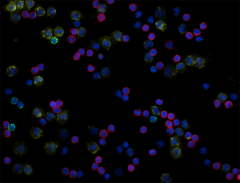
| Cat # | Size | Price | Quantity Check Availability | Save | ||
|---|---|---|---|---|---|---|
| 300446 | 100 µg | 212€ | ||||
CD3ε is a 20 kD chain of the CD3/T-cell receptor (TCR) complex which is composed of two CD3ε, one CD3γ, one CD3δ, one CD3ζ (CD247), and a T-cell receptor (α/β or γ/δ) heterodimer. It is found on all mature T cells, NKT cells, and some thymocytes. CD3, also known as T3, is a member of the immunoglobulin superfamily that plays a role in antigen recognition, signal transduction, and T cell activation.
Product DetailsProduct Details
- Verified Reactivity
- Human
- Reported Reactivity
- Chimpanzee
- Antibody Type
- Monoclonal
- Host Species
- Mouse
- Formulation
- Phosphate-buffered solution, pH 7.2, containing 0.09% sodium azide.
- Preparation
- The antibody was purified by affinity chromatography and conjugated with Alexa Fluor® 594 under optimal conditions.
- Concentration
- 0.5 mg/mL
- Storage & Handling
- The antibody solution should be stored undiluted between 2°C and 8°C, and protected from prolonged exposure to light. Do not freeze.
- Application
-
ICC - Quality tested
FC - Verified
SB - Reported in the literature, not verified in house - Recommended Usage
-
Each lot of this antibody is quality control tested by immunocytochemistry. For immunocytochemistry, a concentration range of 2.5 - 10 μg/mL is recommended. It is recommended that the reagent be titrated for optimal performance for each application.
* Alexa Fluor® 594 has an excitation maximum of 590 nm, and a maximum emission of 617 nm.
Alexa Fluor® and Pacific Blue™ are trademarks of Life Technologies Corporation.
View full statement regarding label licenses - Excitation Laser
-
Green Laser (532 nm)/Yellow-Green Laser (561 nm)
- Application Notes
-
Additional reported applications (for the relevant formats) include: immunohistochemical staining of acetone-fixed frozen sections4,6,7 and formalin-fixed paraffin-embedded sections11, immunoprecipitation1, activation of T cells2,3,5, Western blotting9, and spatial biology (IBEX)16,17. The LEAF™ purified antibody (Endotoxin < 0.1 EU/µg, Azide-Free, 0.2 µm filtered) is recommended for functional assays (Cat. No. 300413, 300414, and 300432). For highly sensitive assays, we recommend Ultra-LEAF™ purified antibody (Cat. No. 300437, 300438, 300465, 300466, 300473, 300474) with a lower endotoxin limit than standard LEAF™ purified antibodies (Endotoxin < 0.01 EU/µg).
- Additional Product Notes
-
Iterative Bleaching Extended multi-pleXity (IBEX) is a fluorescent imaging technique capable of highly-multiplexed spatial analysis. The method relies on cyclical bleaching of panels of fluorescent antibodies in order to image and analyze many markers over multiple cycles of staining, imaging, and, bleaching. It is a community-developed open-access method developed by the Center for Advanced Tissue Imaging (CAT-I) in the National Institute of Allergy and Infectious Diseases (NIAID, NIH).
View more applications data for this product in our Scientific Poster Library. - Application References
-
- Salmeron A, et al. 1991. J. Immunol. 147:3047. (IP)
- Graves J, et al. 1991. J. Immunol. 146:2102. (Activ)
- Lafont V, et al. 2000. J. Biol. Chem. 275:19282. (Activ)
- Ryschich E, et al. 2003. Tissue Antigens 62:48. (IHC)
- Thompson AG, et al. 2004. J. Immunol. 173:1671. (Activ)
- Sakkas LI, et al. 1998. Clin. Diagn. Lab. Immun. 5:430. (IHC)
- Mack CL, et al. 2004. Pediatr. Res. 56:79. (IHC)
- Thakral D, et al. 2008. J. Immunol. 180:7431. (FC) PubMed
- Van Dongen JJM, et al. 1988. Blood 71:603. (WB)
- Yoshino N, et al. 2000. Exp. Anim. (Tokyo) 49:97. (FC)
- Pollard, K. et al. 1987. J. Histochem. Cytochem. 35:1329. (IHC)
- Luckashenak N, et al. 2013. J. Immunol. 190:27. PubMed
- Laurent AJ, et al. 2014. PLoS One. 9:103683. PubMed
- Li J, et al. 2015. Cancer Res. 75:508. PubMed
- Stoeckius M, et al. 2017. Nat. Methods. 14:865-868. (PG)
- Radtke AJ, et al. 2020. Proc Natl Acad Sci USA. 117:33455-33465. (SB) PubMed
- Radtke AJ, et al. 2022. Nat Protoc. 17:378-401. (SB) PubMed
- Product Citations
-
- RRID
-
AB_2563236 (BioLegend Cat. No. 300446)
Antigen Details
- Structure
- Ig superfamily, with the subunits of CD3γ, CD3δ, CD3ζ (CD247) and TCR (α/β or γ/δ) forms CD3/TCR complex, 20 kD
- Distribution
-
Mature T and NK T cells, thymocyte differentiation
- Function
- Antigen recognition, signal transduction, T cell activation
- Ligand/Receptor
- Peptide antigen bound to MHC
- Cell Type
- NKT cells, T cells, Thymocytes, Tregs
- Biology Area
- Immunology, Innate Immunity
- Molecular Family
- CD Molecules, TCRs
- Antigen References
-
1. Barclay N, et al. 1993. The Leucocyte FactsBook. Academic Press. San Diego.
2. Beverly P, et al. 1981. Eur. J. Immunol. 11:329.
3. Lanier L, et al. 1986. J. Immunol. 137:2501-2507. - Gene ID
- 916 View all products for this Gene ID
- UniProt
- View information about CD3 on UniProt.org
Related FAQs
- If an antibody clone has been previously successfully used in IBEX in one fluorescent format, will other antibody formats work as well?
-
It’s likely that other fluorophore conjugates to the same antibody clone will also be compatible with IBEX using the same sample fixation procedure. Ultimately a directly conjugated antibody’s utility in fluorescent imaging and IBEX may be specific to the sample and microscope being used in the experiment. Some antibody clone conjugates may perform better than others due to performance differences in non-specific binding, fluorophore brightness, and other biochemical properties unique to that conjugate.
- Will antibodies my lab is already using for fluorescent or chromogenic IHC work in IBEX?
-
Fundamentally, IBEX as a technique that works much in the same way as single antibody panels or single marker IF/IHC. If you’re already successfully using an antibody clone on a sample of interest, it is likely that clone will have utility in IBEX. It is expected some optimization and testing of different antibody fluorophore conjugates will be required to find a suitable format; however, legacy microscopy techniques like chromogenic IHC on fixed or frozen tissue is an excellent place to start looking for useful antibodies.
- Are other fluorophores compatible with IBEX?
-
Over 18 fluorescent formats have been screened for use in IBEX, however, it is likely that other fluorophores are able to be rapidly bleached in IBEX. If a fluorophore format is already suitable for your imaging platform it can be tested for compatibility in IBEX.
- The same antibody works in one tissue type but not another. What is happening?
-
Differences in tissue properties may impact both the ability of an antibody to bind its target specifically and impact the ability of a specific fluorophore conjugate to overcome the background fluorescent signal in a given tissue. Secondary stains, as well as testing multiple fluorescent conjugates of the same clone, may help to troubleshoot challenging targets or tissues. Using a reference control tissue may also give confidence in the specificity of your staining.
- How can I be sure the staining I’m seeing in my tissue is real?
-
In general, best practices for validating an antibody in traditional chromogenic or fluorescent IHC are applicable to IBEX. Please reference the Nature Methods review on antibody based multiplexed imaging for resources on validating antibodies for IBEX.
Other Formats
View All CD3 Reagents Request Custom ConjugationCustomers Also Purchased
Compare Data Across All Formats
This data display is provided for general comparisons between formats.
Your actual data may vary due to variations in samples, target cells, instruments and their settings, staining conditions, and other factors.
If you need assistance with selecting the best format contact our expert technical support team.
-
APC anti-human CD3

Human peripheral blood lymphocytes stained with UCHT1 APC -
Biotin anti-human CD3
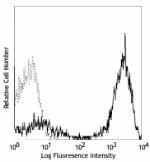
Human peripheral blood lymphocytes stained with biotinylated... -
FITC anti-human CD3
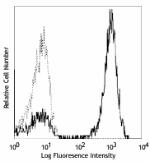
Human peripheral blood lymphocytes stained with UCHT1 FITC -
PE anti-human CD3

Human peripheral blood lymphocytes stained with UCHT1 PE 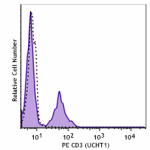
Pre-lysed human blood leukocytes were stained with PE anti-h... -
PE/Cyanine5 anti-human CD3
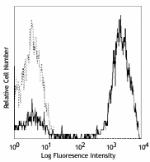
Human peripheral blood lymphocytes stained with UCHT1 PE/Cya... -
Purified anti-human CD3
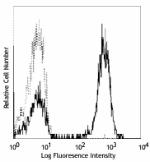
Human peripheral blood lymphocytes stained with purified UCH... 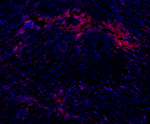
Human frozen spleen tissue slices were fixed with 4% PFA for... -
Alexa Fluor® 647 anti-human CD3
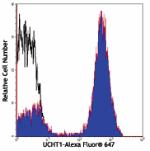
Human peripheral blood lymphocytes stained with UCHT1 Alexa ... 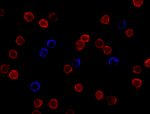
Human peripheral mononuclear cells were fixed with 2% parafo... 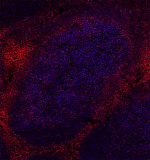
Human frozen tonsil tissue slices were fixed with 4% PFA for... -
Alexa Fluor® 488 anti-human CD3
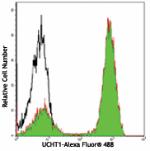
Human peripheral blood lymphocytes stained with UCHT1 Alexa ... 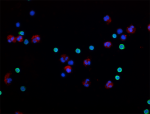
Human peripheral blood mononuclear cells and neutrophil mixe... 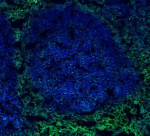
Human frozen tonsil tissue slices were fixed with 4% PFA for... -
Pacific Blue™ anti-human CD3
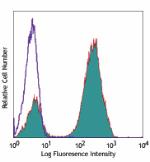
Human peripheral blood lymphocytes stained with UCHT1 Pacifi... -
PE/Cyanine7 anti-human CD3

Human peripheral blood lymphocytes stained with UCHT1 PE/Cya... -
Alexa Fluor® 700 anti-human CD3
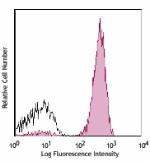
Human peripheral blood lymphocytes stained with UCHT1 Alexa ... -
APC/Cyanine7 anti-human CD3

Human peripheral blood lymphocytes were stained with CD19 FI... -
PerCP anti-human CD3
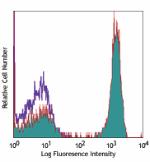
Human peripheral blood lymphocytes stained with UCHT1 PerCP -
PerCP/Cyanine5.5 anti-human CD3

Human peripheral blood lymphocytes were stained with CD3 (cl... -
Brilliant Violet 421™ anti-human CD3
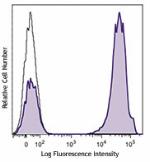
Human peripheral blood lymphocytes were stained with CD3 (cl... 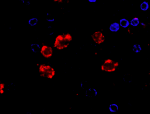
Human peripheral blood mononuclear cells were fixed with 2% ... 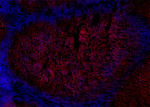
Human frozen tonsil tissue slices were fixed with 4% PFA for... -
Brilliant Violet 570™ anti-human CD3
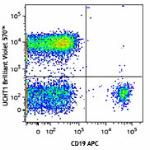
Human peripheral blood lymphocytes were stained with CD19 AP... 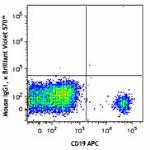
-
Ultra-LEAF™ Purified anti-human CD3
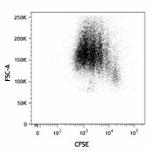
Human peripheral blood lymphocytes stained with LEAF™ purifi... 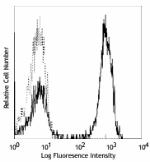
Human peripheral blood lymphocytes stained with LEAF™ purifi... 
Human peripheral blood mononuclear cells were stained with C... -
Purified anti-human CD3 (Maxpar® Ready)
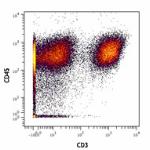
Human PBMCs stained with 154Sm-anti-CD45 (HI30) and 170Er-an... -
Alexa Fluor® 594 anti-human CD3
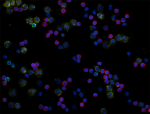
Human peripheral blood mononuclear cells were fixed with 2% ... 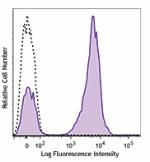
Human peripheral blood lymphocytes were stained with CD3 (cl... 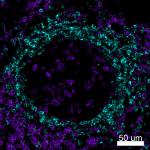
Confocal image of human lymph node sample acquired using the... 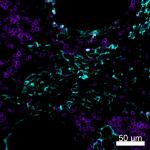
Confocal image of human lymph node sample acquired using the... -
PE/Dazzle™ 594 anti-human CD3
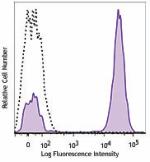
Human peripheral blood lymphocytes were stained with CD3 (cl... -
Brilliant Violet 510™ anti-human CD3
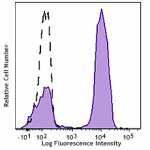
Human peripheral blood lymphocytes were stained with CD3 (cl... -
Brilliant Violet 605™ anti-human CD3
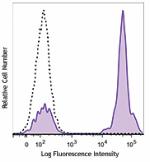
Human peripheral blood lymphocytes stained with CD3 (clone U... -
Brilliant Violet 711™ anti-human CD3
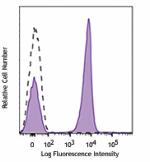
Human peripheral blood lymphocytes were stained with CD3 (cl... -
Brilliant Violet 650™ anti-human CD3
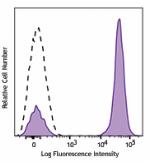
Human peripheral blood lymphocytes were stained with CD3 (cl... -
APC/Fire™ 750 anti-human CD3
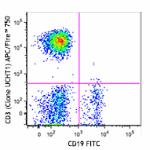
Human peripheral blood lymphocytes were stained with CD19 FI... 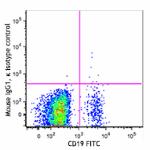
-
Pacific Blue™ anti-human CD3

Typical results from human peripheral blood lymphocytes stai... -
Brilliant Violet 785™ anti-human CD3
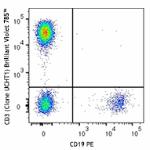
Human peripheral blood lymphocytes were stained with CD19 PE... 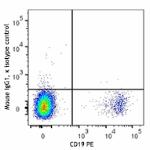
-
PE/Dazzle™ 594 anti-human CD3
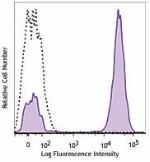
Typical results from human peripheral blood lymphocytes stai... -
TotalSeq™-A0034 anti-human CD3
-
TotalSeq™-B0034 anti-human CD3
-
TotalSeq™-C0034 anti-human CD3
-
PE anti-human CD3

Typical results from human peripheral blood lymphocytes stai... -
PE/Cyanine7 anti-human CD3

Typical results from human peripheral blood lymphocytes stai... -
KIRAVIA Blue 520™ anti-human CD3

Human Peripheral blood lymphocytes were stained with CD19 AP... -
Spark Violet™ 538 anti-human CD3 Antibody
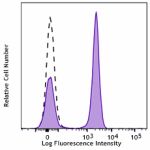
Human peripheral blood lymphocytes were stained with CD3 (cl... -
TotalSeq™-D0034 anti-human CD3
-
Spark Blue™ 574 anti-human CD3 Antibody

Human peripheral blood lymphocytes were stained with anti-hu... -
GMP Pacific Blue™ anti-human CD3
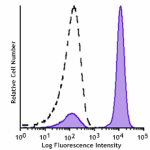
Typical results from human peripheral blood lymphocytes stai... -
GMP PE anti-human CD3
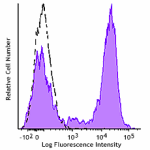
Typical results from human peripheral blood lymphocytes stai... -
GMP PE/Dazzle™ 594 anti-human CD3
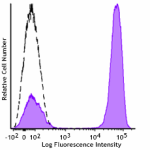
Typical results from human peripheral blood lymphocytes stai... -
Spark Violet™ 423 anti-human CD3

Human peripheral blood lymphocytes were stained with anti-hu... -
GMP PE/Cyanine7 anti-human CD3
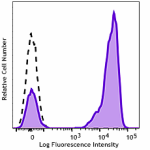
Typical results from human peripheral blood lymphocytes stai... -
Spark Blue™ 515 anti-human CD3

Human peripheral blood cells were surface stained with anti-... -
APC/Fire™ 810 anti-human CD3

Human peripheral blood lymphocytes were stained with anti-hu...

 Login / Register
Login / Register 















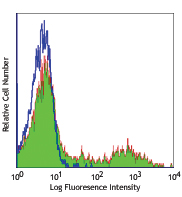


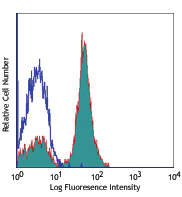



Follow Us